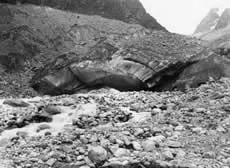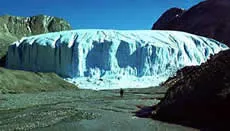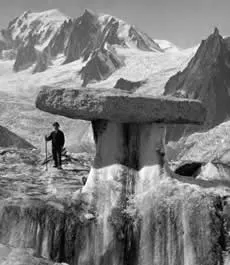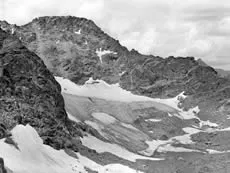a cave of ice, usually underneath a glacier and formed by meltwater; cave entrances are often enlarged near a glacier terminus by warm winds; most common on stagnant portions of glaciers.
A small stream flows from the glacier cave at the terminus of Arolla Glacier in the Pennine Alps. Photograph from 1902.
H.F. Reid, archived at the World Data Center for Glaciology, Boulder, CO
a phenomenon in which strong reflection of the sun on an icy surface causes a glacier to look like it is on fire.
a sudden outburst of water released by a glacier.
a fine powder of silt- and clay-sized particles that a glacier creates as its rock-laden ice scrapes over bedrock; usually flushed out in meltwater streams and causes water to look powdery gray; lakes and oceans that fill with glacier flour may develop a banded appearance; also called rock flour.
well-bonded ice crystals compacted from snow with a bulk density greater than 860 kilograms per cubic-meter (55 pounds per cubic-foot).
a nearly vertical channel in ice that is formed by flowing water; usually found after a relatively flat section of glacier in a region of transverse crevasses.
potholes formed at the bottom of glaciers through erosion caused by sand and gravel in melt-water; melt-water seeps through crevasses in the glaciers, sometimes forming whirpools; at the bottom of the glacier, the water is under very high pressure, leading to erosion of underlying rocks.
a glacier that is reconstructed or reconstituted out of other glacier material; usually formed by seracs falling from a hanging glacier, then re-adhering; also called reconstituted, reconstructed or regenerated glacier.
the lowest end of a glacier; also called glacier terminus or toe.
Glacier at the head of Canon Fiord, Ellesmere Island, Canada
the bottom of the ice of a glacier.
a rock that resides on a pedestal of ice; formed by differential ablation between the rock-covered ice and surrounding bare ice.
Talefre Glacier on Mont Blanc Massif in the European Alps sported a prominent glacier table when this undated photograph was taken. The rock protected the ice directly below it from melting, resulting in the characteristic pedestal that remains after the surrounding ice melts. For scale, note the man standing behind and to the left of the pedestal.
Cairrar, archived at the World Data Center for Glaciology, Boulder, CO
the lowest end of a glacier; also called glacier snout or toe.
Glacier at the head of Canon Fiord, Ellesmere Island, Canada
the lowest end of a glacier; also called glacier snout or terminus.
Glacier at the head of Canon Fiord, Ellesmere Island, Canada
an extension of a glacier or ice stream projecting seaward, usually afloat.
u-shaped valleys transformed from v-shaped stream valleys due to erosion caused by passing glaciers.
a localized current of air occuring as a result of a glacier's melting processes; when the surface of glacial ice melts, the air above the glacier cools and becomes heavier than the surrounding air and flows down the glacial valley; glacier wind can also be wind that flows out of ice caves; a kind of katabatic wind.
a very small glacier.
Arapaho Glacier, located along the Front Range, Colorado, in 1956. Although relatively small in terms of glacier size, the city of Boulder, Colorado, still receives some of its drinking water from Arapaho Glacier runoff.
World Data Center for Glaciology, Boulder, CO
land overlaid at present by a glacier is said to be covered; the alternative term glacierized has not found general favour.
a coating of ice, generally clear and smooth but usually containing some air pockets, formed on exposed objects by freezing of a film of super-cooled water deposited by rain, drizzle, fog, or possibly condensed from super-cooled water vapor; glaze is denser, harder and more transparent, than either rime or hoarfrost.
global network of observational stations which is the coordinated system of methods, techniques and facilities for making observations on a world-wide scale in the framework of the World Weather Watch, a World Meteorological Organization program.





